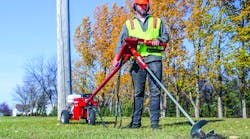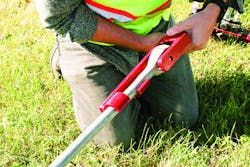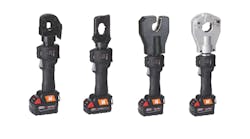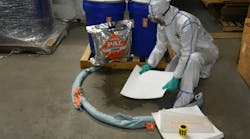Linemen often work high above the ground and in close proximity to high-voltage cables. At one large utility company, however, the anchor crew members were staying grounded, yet they were facing a significantly higher rate of injuries than their lineman counterparts.
Every day, these crew members focused on installing 4-ft anchors to secure the cables supporting utility poles with an anchor-driving tool — a high-speed, hand-held drill known as an “anchor cranker.” This drill, which required two users to operate, featured two large handles and a high-speed rotary.
Experiencing Lost Time and Injuries
The anchor cranker, which looks like a chainsaw engine, had a high RPM. If the operators struck an underground object or drove the tool deep into the ground, they were likely to lose their grip and control of the tool.
When both operators let go of the tool, the machine’s torque instantly transferred from driving the anchor into the ground to spinning the metal handles above the ground — inflicting leg and lower-body injuries. As a result of this tool, the anchor crew members experienced injuries, filed workman’s compensation claims and logged loss time.
Discovering a New Drill
To protect the anchor crews from drilling torque, the utility company’s safety specialist discovered a drill from Little Beaver Inc. The manufacturer invented a steel torque tube, which connects to the handles at one end and to the hydraulic power source at the other end. That way, if the auger strikes an object or needs additional torque to power through tough soil, the tube transfers kickback to the power unit, bypassing the operator and nearly eliminating the risk of strain or serious injury, according to the manufacturer.
Making Modifications
When the anchoring crews went to work with their new hydraulic earth drills, however, they ran into a problem. While the torque tube was suitable for transferring torque, it also restricted where they could place anchors. The length of the tube dictated where the power unit could be positioned since the torque tube extends directly back from the operator to the power unit, according to Little Beaver. With the pole being anchored directly behind the operator, the length of the tube restricted where the operator could drill.
Little Beaver responded by creating adjustable-length torque tubes. As a result, the operators could adjust the placement of the power unit to accommodate the ideal anchor location. This solution worked, and the utility company ordered the drills for each of its anchoring crews.
Boosting Productivity
By using the new drills, the utility crews not only were able to work more safely, but also more efficiently. Along with reaping the benefit of torque-free drilling, the crews were also able to drive anchors more quickly, improving their productivity on the job.
For example, the crews could drive an anchor into place in seconds. The anchor crankers, in comparison, could cause the anchors to get stuck under a root or buried object. The crews would then have to manually dislodge the anchors by twisting them out by hand, which could take up to 45 minutes. The hydraulic drills from Little Beaver, however, are equipped with reverse, which allows them to back out in seconds if an anchor gets stuck.
The utility company has also found that hydraulic drills are a better alternative to installing the anchors by hand, which can take as long as 10 minutes. When you factor in the driving time between locations, it can average about one anchor per hour. By using hydraulic rigs, the utility company crews can be two to three times more efficient than if they installed all the anchors by hand.
Switching from anchor crankers to Little Beaver hydraulic drills has reduced the high number of injuries to nearly zero. In addition, the drill has boosted the workers’ productivity, allowing them to get more work done in less time.



